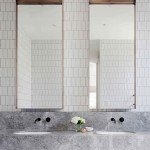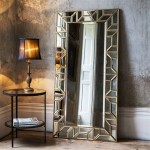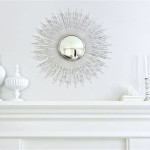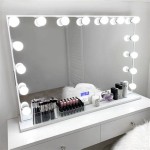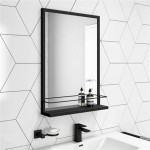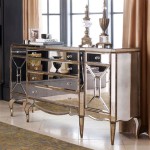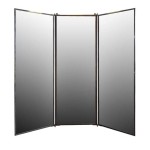How To Add a Frame to an Existing Mirror
Adding a frame to an existing mirror is a straightforward project that can dramatically enhance its aesthetic appeal and integrate it seamlessly into a room's decor. This process involves accurately measuring the mirror, selecting appropriate framing materials, and employing proper construction techniques for a professional-looking result. This article provides a comprehensive guide to framing an existing mirror.
Necessary Tools and Materials: Before beginning, gather all required materials. These typically include the chosen frame material (wood, metal, or plastic), measuring tape, a miter saw or miter box with a hand saw for angled cuts (if using wood or other cuttable material), adhesive suitable for the frame material and mirror, clamps or weights, safety glasses, and protective gloves. Optional materials include wood filler, sandpaper, paint or stain for wooden frames, and finishing nails.
Accurate Measurement is Key: Precise measurements are crucial for a well-fitting frame. Measure the mirror's length and width carefully, recording the dimensions to the nearest eighth of an inch. These measurements will determine the length of the frame pieces. The width of the frame material will dictate the necessary overlap, influencing how the frame sits over the mirror's edge. Consider whether the frame will sit flush with the mirror's surface or extend slightly beyond it.
Selecting the Right Frame Material: The choice of frame material significantly impacts the final look. Wood offers a classic and versatile option, adaptable to various finishes and styles. Metal frames provide a sleek, modern appearance, while plastic frames are often a lightweight and cost-effective choice. Consider the existing decor of the room and the desired aesthetic when selecting the material. The weight of the material is also a factor, especially for larger mirrors.
Cutting and Preparing the Frame Pieces: For wood or other cuttable frame materials, accurate cutting is essential. A miter saw or miter box and hand saw allow for precise 45-degree angle cuts, ensuring tight, seamless corners. Mark the measurements carefully on the frame material before cutting. If using wood, light sanding can smooth the cut edges. For pre-fabricated frames, this step is unnecessary. If painting or staining a wooden frame, do so before assembly.
Applying Adhesive and Assembling the Frame: Select an adhesive appropriate for both the frame material and the mirror's backing. Construction adhesive or specialized mirror adhesive often works well. Apply the adhesive to the back edges of the frame pieces, ensuring even coverage. Carefully position the frame pieces onto the mirror, aligning the edges precisely. Clamps or weights can help secure the frame while the adhesive dries. Follow the adhesive manufacturer's instructions for drying time.
Securing and Reinforcing the Frame (Optional): For added stability, especially with larger or heavier frames, consider reinforcing the corners. Small finishing nails, strategically placed and countersunk, can provide extra support. If using wood filler, apply it to cover nail holes and any gaps between the frame and mirror. Sand the filler smooth once dry, creating a seamless finish.
Hanging the Framed Mirror: Once the adhesive has fully cured and any filler has dried, the framed mirror is ready to hang. The hanging method depends on the mirror's size and weight. For lighter mirrors, D-rings or wire hangers attached to the back of the frame are often sufficient. Heavier mirrors may require more robust hanging hardware, such as French cleats or heavy-duty mirror hangers. Ensure the chosen hanging method is appropriate for the weight and size of the mirror and follow the hardware manufacturer's instructions for installation.
Safety Precautions: Throughout the entire framing process, prioritize safety. Wear safety glasses when cutting frame materials and handling adhesive. Protective gloves can prevent skin irritation from adhesives and stains. Work in a well-ventilated area when using adhesives, paints, or stains. If using power tools, familiarize yourself with their operation and safety guidelines before beginning the project.
Considerations for Different Frame Materials: Different frame materials require specific considerations. Metal frames may require specialized adhesives and cutting tools. Plastic frames are often lightweight and easy to cut but can be brittle. Wood offers versatility but requires more preparation and finishing. Consider the specific properties of the chosen material when planning and executing the project.
Alternative Framing Techniques: While the adhesive method is common and effective, alternative techniques exist. For instance, some pre-fabricated frames are designed to clip onto the mirror's edge, eliminating the need for adhesive. Other methods might involve creating a backing board for the mirror and then attaching the frame to the board. Research different techniques to determine the most suitable approach for the specific mirror and frame material.

Mirror Stuck On The Wall Add A Frame To An Plate Glass In Minutes Kits Bathroom Mirrors Diy

Mirror Frame Diy How To Update A Basic Bathroom Our Faux Farmhouse

How To Easily Make A Custom Mirror Frame

How To Frame A Mirror Erfly House

Mirror Frame Diy How To Update A Basic Bathroom Our Faux Farmhouse

Diy Mirror Frames Custom Framed Mirrors Frame Bathroom Large

How To Easily Make A Custom Mirror Frame

How To Add A Rustic Mirror Frame Your Existing Bathroom Budget Friendly Diy

Mirror Frame Diy How To Update A Basic Bathroom Our Faux Farmhouse

Diy Wood Frame Mirror Makeover With Hooks Funky Junk Interiors

